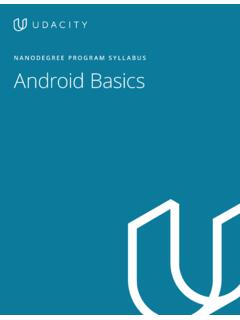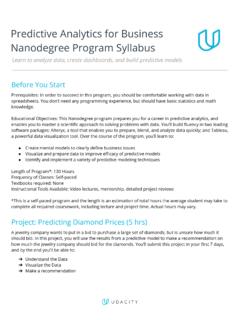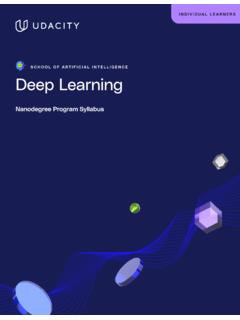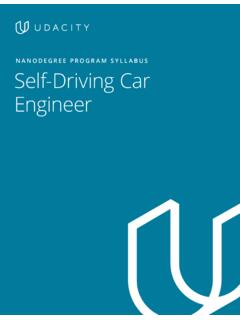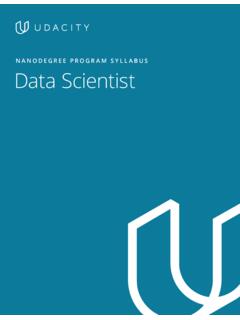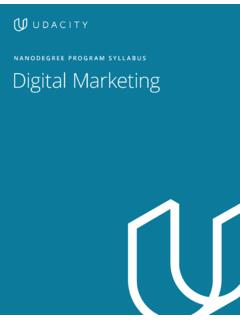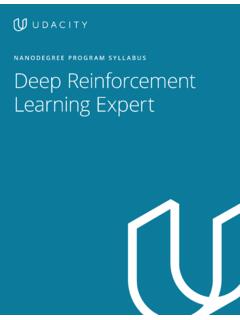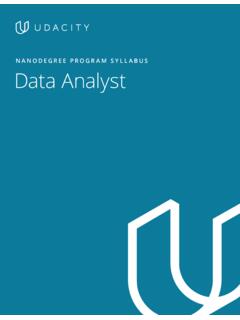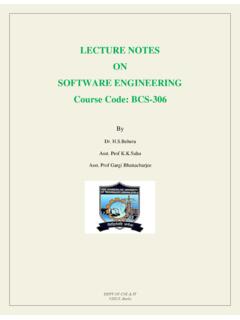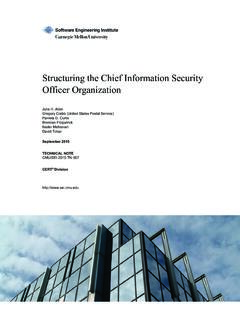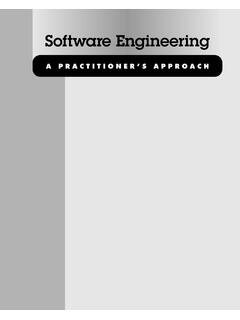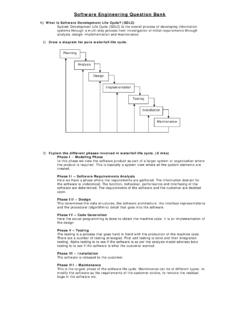Transcription of NANODEGREE PROGRAM SYLLABUS Data Engineering
1 Data EngineeringNANODEGREE PROGRAM SYLLABUSData Engineering | 2 OverviewLearn to design data models, build data warehouses and data lakes, automate data pipelines, and work with massive datasets. At the end of the PROGRAM , you ll combine your new skills by completing a capstone should have intermediate SQL and Python programming Objectives: Students will learn to Create user-friendly relational and NoSQL data models Create scalable and efficient data warehouses Work efficiently with massive datasets Build and interact with a cloud-based data lake Automate and monitor data pipelines Develop proficiency in Spark, Airflow, and AWS toolsPrerequisites: Intermediate Python & SQLF lexible Learning: Self-paced, so you can learn on the schedule that works best for youEstimated Time: 5 Months at 5 hrs/weekIN COLLABORATION WITHT echnical Mentor Support: Our knowledgeable mentors guide your learning and are focused on answering your questions, motivating you and keeping you on track Data Engineering | 3 Course 1.
2 Data ModelingIn this course, you ll learn to create relational and NoSQL data models to fit the diverse needs of data consumers. You ll understand the differences between different data models, and how to choose the appropriate data model for a given situation. You ll also build fluency in PostgreSQL and Apache OUTCOMESLESSON ONEI ntroduction to DataModeling Understand the purpose of data modeling Identify the strengths and weaknesses of different types of databases and data storage techniques Create a table in Postgres and Apache CassandraLESSON TWOR elational Data Models Understand when to use a relational database Understand the difference between OLAP and OLTP databases Create normalized data tables Implement denormalized schemas ( STAR, Snowflake)Course Project Data Modeling with Apache CassandraIn these projects, you ll model user activity data for a music streaming app called Sparkify. You ll create a database and ETL pipeline, in both Postgres and Apache Cassandra, designed to optimize queries for understanding what songs users are listening to.
3 For PostgreSQL, you will also define Fact and Dimension tables and insert data into your new tables. For Apache Cassandra, you will model your data so you can run specific queries provided by the analytics team at Project Data Modeling with PostgresIn this project, you ll model user activity data for a music streaming app called Sparkify. You ll create a relational database and ETL pipeline designed to optimize queries for understanding what songs users are listening to. In PostgreSQL you will also define Fact and Dimension tables and insert data into your new Engineering | 4 LESSON THREENoSQL Data Models Understand when to use NoSQL databases and how they differ from relational databases Select the appropriate primary key and clustering columns for a given use case Create a NoSQL database in Apache CassandranData Engineering | 5 Course 2: Cloud Data WarehousesIn this course, you ll learn to create cloud-based data warehouses.
4 You ll sharpen your data warehousing skills, deepen your understanding of data infrastructure, and be introduced to data Engineering on the cloud using Amazon Web Services (AWS).LEARNING OUTCOMESLESSON ONEI ntroduction to theData Warehouses Understand Data Warehousing architecture Run an ETL process to denormalize a database (3NF to Star) Create an OLAP cube from facts and dimensions Compare columnar vs. row oriented approachesLESSON TWOI ntroduction to theCloud with AWS Understand cloud computing Create an AWS account and understand their services Set up Amazon S3, IAM, VPC, EC2, RDS PostgreSQLESSON THREEI mplementing DataWarehouses on AWS Identify components of the Redshift architecture Run ETL process to extract data from S3 into Redshift Set up AWS infrastructure using Infrastructure as Code (IaC) Design an optimized table by selecting the appropriate distribution style and sorting keyCourse Project Build a Cloud Data WarehouseIn this project, you are tasked with building an ELT pipeline that extracts their data from S3, stages them in Redshift, and transforms data into a set of dimensional tables for their analytics team to continue finding insights in what songs their users are listening Engineering | 6 Course 3.
5 Spark and Data LakesIn this course, you will learn more about the big data ecosystem and how to use Spark to work with massive datasets. You ll also learn about how to store big data in a data lake and query it with OUTCOMESLESSON ONEThe Power of Spark Understand the big data ecosystem Understand when to use Spark and when not to use itLESSON TWOData Wrangling with Spark Manipulate data with SparkSQL and Spark Dataframes Use Spark for ETL purposesLESSON THREED ebugging andOptimization Troubleshoot common errors and optimize their code using the Spark WebUILESSON FOURI ntroduction to Data Lakes Understand the purpose and evolution of data lakes Implement data lakes on Amazon S3, EMR, Athena, and Amazon Glue Use Spark to run ELT processes and analytics on data of diverse sources, structures, and vintages Understand the components and issues of data lakesCourse Project Build a Data LakeIn this project, you ll build an ETL pipeline for a data lake.
6 The data resides in S3, in a directory of JSON logs on user activity on the app, as well as a directory with JSON metadata on the songs in the app. You will load data from S3, process the data into analytics tables using Spark, and load them back into S3. You ll deploy this Spark process on a cluster using Engineering | 7 Course 4: Automate Data PipelinesIn this course, you ll learn to schedule, automate, and monitor data pipelines using Apache Airflow. You ll learn to run data quality checks, track data lineage, and work with data pipelines in OUTCOMESLESSON ONEData Pipelines Create data pipelines with Apache Airflow Set up task dependencies Create data connections using hooksLESSON TWOData Quality Track data lineage Set up data pipeline schedules Partition data to optimize pipelines Write tests to ensure data quality Backfill dataLESSON THREEP roduction DataPipelines Build reusable and maintainable pipelines Build your own Apache Airflow plugins Implement subDAGs Set up task boundaries Monitor data pipelinesCourse Project Data Pipelines with AirflowIn this project, you ll continue your work on the music streaming company s data infrastructure by creating and automating a set of data pipelines.
7 You ll configure and schedule data pipelines with Airflow and monitor and debug production Engineering | 8 Course 4: Capstone ProjectCombine what you ve learned throughout the PROGRAM to build your own data Engineering portfolio Project Data Engineering CapstoneThe purpose of the data Engineering capstone project is to give you a chance to combine what you ve learned throughout the PROGRAM . This project will be an important part of your portfolio that will help you achieve your data Engineering -related career this project, you ll define the scope of the project and the data you ll be working with. We ll provide guidelines, suggestions, tips, and resources to help you be successful, but your project will be unique to you. You ll gather data from several different data sources;transform, combine, and summarize it; and create a clean database for others to Engineering | 9 Our Classroom ExperienceREAL-WORLD PROJECTSB uild your skills through industry-relevant projects.
8 Get personalized feedback from our network of 900+ project reviewers. Our simple interface makes it easy to submit your projects as often as you need and receive unlimited feedback on your answers to your questions with Knowledge, ourproprietary wiki. Search questions asked by other students,connect with technical mentors, and discover in real-timehow to solve the challenges that you encounter. WORKSPACESSee your code in action. Check the output and quality of your code by running them on workspaces that are a part of our your understanding of concepts learned in the PROGRAM by answering simple and auto-graded quizzes. Easily go back to the lessons to brush up on concepts anytime you get an answer STUDY PLANSC reate a custom study plan to suit your personal needs and use this plan to keep track of your progress toward your TRACKERStay on track to complete your NANODEGREE PROGRAM with useful milestone Engineering | 10 Learn with the BestBen GoldbergSTAFF ENGINEERAT SPOTHEROIn his career as an engineer, Ben Goldberg has worked in fields ranging from Computer Vision to Natural Language Processing.
9 At SpotHero, he founded and built out their Data Engineering team, using Airflow as one of the key Serrano CEO AT NOVELARI & ASSISTANT PROFES-SOR AT NILE UNIVERSITYS ameh is the CEO of Novelari, lecturer at Nile University, and the American University in Cairo (AUC) where he lectured on security, distributed systems, software Engineering , blockchain and BigData Paster DATA ENGINEERAT WOLTOlli works as a Data Engineer at Wolt. He has several years of experience on building and managing data pipelines on various data warehousing environments and has been a fan and active user of Apache Airflow since its first Moran DEVELOPER ADVOCATEAT DATA STA XAmanda is a developer Advocate for DataStax after spending the last 6 years as a software Engineer on 4 different distributed databases. Her passion is bridging the gap between customers and Engineering . She has degrees from University of Washington and Santa Clara Universit Engineering | 11 Learn with the BestJudit LantosDATA ENGINEERAT SPLITJ udit was formerly an instructor at Insight Data Science helping software engineers and academic coders transition to DE roles.
10 Currently, she is a Data Engineer at Split where she works on the statistical engine of their full-stack experimentation Lee CURRICULUM LEADAT UDACIT YJuno is the curriculum lead for the School of Data Science. She has been sharing her passion for data and teaching, building several courses at Udacity. As a data scientist, she built recommendation engines, computer vision and NLP models, and tools to analyze user Drummond VP OF ENGINEERINGAT INSIGHTD avid is VP of Engineering at Insight where he enjoys breaking down difficult concepts and helping others learn data Engineering . David has a PhD in Physics from UC Engineering | 12 All Our NANODEGREE programs Include:TECHNICAL MENTOR SUPPORTMENTORSHIP SERVICES Questions answered quickly by our team of technical mentors 1000+ Mentors with a average rating Support for all your technical questionsEXPERIENCED PROJECT REVIEWERSREVIEWER SERVICES Personalized feedback & line by line code reviews 1600+ Reviewers with a average rating 3 hour average project review turnaround time Unlimited submissions and feedback loops Practical tips and industry best practices Additional suggested resources to improvePERSONAL CAREER SERVICESCAREER SUPPORT Github portfolio review LinkedIn profile optimizationData Engineering | 13 Frequently Asked QuestionsPROGRAM OVERVIEWWHY SHOULD I ENROLL?
